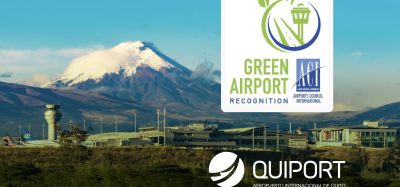Integrating drone operations at airports
Posted: 11 August 2021 | Paul Diestelkamp | No comments yet
Drones are a potential game-changer for airport operations – particularly because they can cover ground and reach heights faster than ground-based human teams. Today, as commercial drone usage is becoming ever more mainstream, what challenges do airports face in integrating these very useful tools safely and efficiently, and how can they build an effective operating framework for the future? Paul Diestelkamp, Head of Business Development & Solutions at Air Navigation Solutions (ANSL), explains.


Drone dynamics
Drone ownership and usage has grown exponentially over the past five years, and this trend isn’t showing any signs of slowing down. Unsurprisingly, adding hundreds of often untracked flying objects has had a major impact on airports, who have been used to uncluttered (or, at least, well managed) airspace in recent years. The example that most people will remember is the closure of London Gatwick Airport (LGW) in the lead up to Christmas 2018.
The three-day incident, caused by a series of drone sightings, disrupted over 1,000 flights, more than 140,000 passengers, and cost the airport £1.4 million. As Gatwick’s air navigation services provider (ANSP), Air Navigation Solutions (ANSL) quickly devised new operating procedures that, together with the new equipment brought in, enabled the airport to safely resume air traffic operations.
Three years on, protection against such incidents has become a staple of airport security. The UK Civil Aviation Authority (CAA) has recently updated its guidance to control the use of drones near airports. This update will help to manage drone pilots with good intentions – although airports will need to remain vigilant for malicious operators.
Furthermore, the concept of a ‘remote ID’ for drones, similar to Manufacturer Serial Numbers (MSNs) used by conventional aircraft, has already been mandated in the US. Whilst conversations in Europe are underway, we are yet to see meaningful movement on this in the region.
All this being said, the meaningful integration of drones onto existing air traffic management (ATM) systems is yet to take place. Having recognised the need within the airport environment, and building on experience gained during the Gatwick incident, ANSL has created an integrated Drone Operations on Airports (iDOAirports) framework in order to proactively prepare for the anticipated boom in drone numbers and utility at airports.
A template for drone integration at airports
ANSL’s iDOAirports framework enables drones to be safely and efficiently integrated into the air traffic management (ATM) operation on airports, without the need for segregation or the temporary local suspension of air traffic – a current necessity. The framework was trialled in August 2020 at Gatwick, for the first time demonstrating how drones and traditional air traffic could operate in harmony on an airport.
The framework brings together technical equipment and data integration, integration of procedures and standards, and the full and true integration of operations on airports. It is designed to facilitate safe and flexible drone operations in busy and complex ATM environments – without the need for segregation. This approach will hugely increase the operational availability of drones, unlocking their potential to deliver efficient and cost-effective services at airports in real-time.
Whilst iDOAirports can provide a strong platform, airports must look forward towards an all-encompassing solution which reaches beyond their perimeters and is built for the future – namely, ensuring that Unmanned Aircraft System Traffic Management (UTM) and Air Traffic Management (ATM) merge to work in harmony. They must integrate, or risk dis-integration.
Integrate, or risk dis-integration
Methods of future air mobility will only ever be possible as an integrated capability that interacts with conventional air traffic. This integration will be necessary if the drone industry is to realise its meteoric forecasted rise. Drones are estimated to increase the UK’s GDP by £42 billion and create a net cost savings for its economy of £16 billion by 2030.
Clear rules exist for participation in the air traffic system, and all users of the crowded airspace must demonstrably adhere to these standards. By necessity, drones and, in the future, Advanced Air Mobility (AAM) vehicles, must also meet these requirements in order to maintain the integrity of the system.
The current system for managing air traffic requires a high level of direct engagement however, and an even higher level of manual management. To allow for the forecasted growth of drones and future air mobility operators, and to facilitate the integration of manned and unmanned, manual and autonomous air traffic, a new system will be required.
The future systems and frameworks governing airspace should be able to adapt to the changing demand and utilisation presented at any given point in time. Only a dynamic and flexible environment will be able to facilitate the anticipated volume of traffic whilst ensuring safe, orderly and expeditious journeys.
The next step for the ATM industry is to look at options for comprehensively integrating UTM and ATM and ANSL is driving innovation in this space, to deliver a scalable environment for flexible and integrated operations. This will also lay the foundations for the large-scale integration of Autonomous/Advanced Air Mobility (AAM) further into the future. Airports specifically are exploring the potential of future innovation already, and rightly consider Urban Air Mobility (UAM), AAM and other potentially revolutionary developments as an important part of their medium-long term business strategies.
As the necessary frameworks, concepts and principles are discussed, developed and implemented around the world, it is vital for the continued safe navigation of our skies that airports and ATM providers drive innovation and deliver integration. It is for us, the stakeholders of our industry, to deliver a future that not only ensures safety, but helps realise the incredible potential of Future Air Mobility, and at Air Navigation Solutions we will certainly be at the forefront of this innovation.
Paul Diestelkamp – Head of Business Development & Solutions at Air Navigation Solutions (ANSL)


The International Airport Summit is open for registration!
Date: 19 – 20 November 2025
Location: JW Marriott Hotel Berlin
At our flagship event of the year, we will dive into the future of airport operations, with expert-led sessions on passenger experience, innovative smart technologies, baggage handling, airside operations, data, security, and sustainability.
This is where global airport leaders come together to share insights, challenges, and real-world solutions.
Limited complimentary passes are available for eligible professionals – first come, first served!
Related topics
Air traffic control/management (ATC/ATM), Airside operations, Drones


















